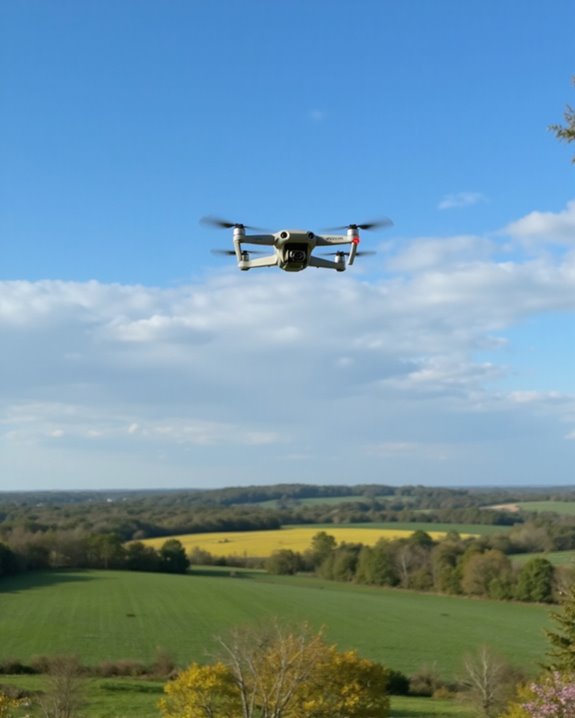Drone weight capacity varies dramatically across models! Small consumer drones like the DJI Mini 3 carry under half a pound, while mid-sized commercial drones handle 1-3 pounds. For serious lifting, industrial drones like the GRIFF Aviation 300 can transport up to 500 pounds of cargo. Remember, heavier payloads greatly reduce flight time – the Aurelia X8 drops from 25 to just 12 minutes with an 8kg load. The perfect drone balances weight capacity with your specific mission needs.
Key Takeaways
- Mini drones like DJI Mini 3 carry less than half a pound, while medium drones lift 400-1460 grams for commercial use.
- Large industrial drones can carry between a few kilograms and 227 kg, enabling versatile commercial applications.
- Military drones like the MQ-9 Reaper can haul up to 3,850 pounds of armament and sensor equipment.
- Payload capacity is determined by motor power, battery efficiency, frame strength, and thrust-to-weight ratio.
- Increased payload weight reduces flight time, with examples like Aurelia X8 dropping from 25 to 12 minutes with 8 kg.
Understanding Drone Payload Capacity Basics
When it comes to drones, how much weight they can carry is often the million-dollar question for both hobbyists and professionals alike. The answer lies in understanding payload capacity—the additional weight a drone can lift beyond its own mass.
Several Payload Factors determine this lifting ability, including motor power, battery efficiency, and the drone’s frame strength. Thrust Concepts are particularly essential, as the propellers must generate enough force to overcome gravity for both the drone and its cargo. Think of it like trying to carry groceries upstairs—the heavier the bags, the more strength you need!
Flight time decreases as payload increases, which explains why many industrial drones can lift impressive weights but only for short periods. The perfect balance between weight and flight time is every drone operator’s ultimate quest! For example, the Heavy Lift Agricultural Drone balances a 30KG payload capacity with extended flight time to cover large areas efficiently.
Mini to Medium Drone Weight Limits
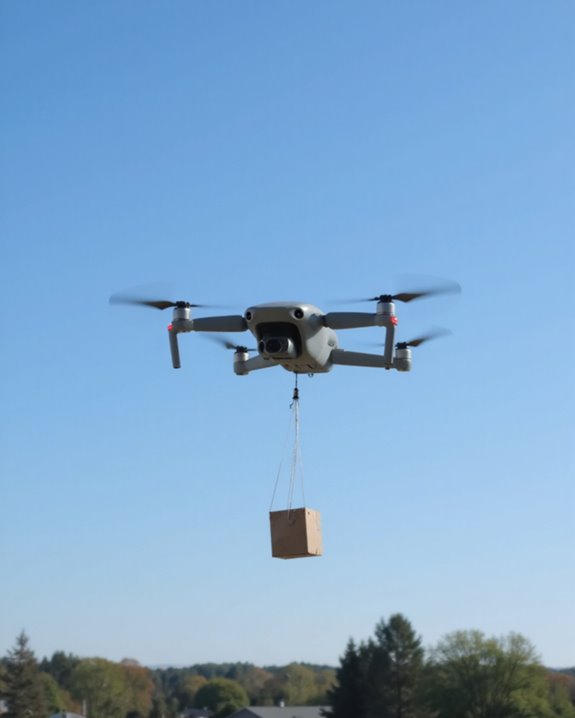
Now that we’ve established the fundamentals of payload capacity, let’s explore how these principles apply to specific drone categories in the real world.
Mini drones like the DJI Mini 3 weigh around 248 grams and typically carry payloads under half a pound. Weather Factors greatly impact these lightweight flyers – even moderate wind can reduce their effective payload capacity! Middleweight drones, ranging from 1-600 kg, offer substantially greater lifting capabilities (400-1460 grams), making them ideal for commercial applications like surveying. Many mini drones also feature wind resistance up to 38 kph, helping maintain stability during flight in challenging conditions.
Large Drone Carrying Capabilities
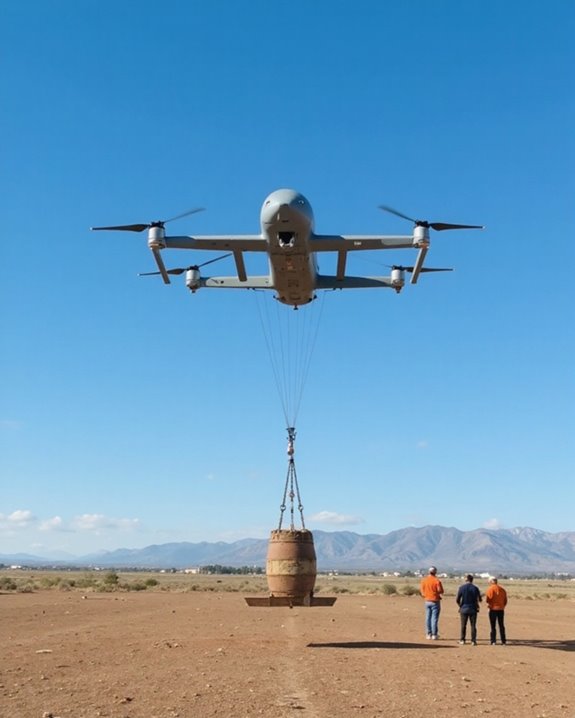
Why are large drones revolutionizing industries worldwide? Their impressive payload capacities—ranging from a few kilograms to a whopping 227 kg—make them versatile workhorses in today’s technology landscape. Models like the GRIFF Aviation 300 lead the pack, while the EH216-S supports an impressive 220 kg payload, making Human Transport applications increasingly viable!
These aerial powerhouses adapt to various environments through customizable features, with Environmental Adaptation capabilities allowing them to perform in challenging conditions. Need to transport heavy construction materials to remote sites? No problem! Looking to mount professional camera equipment weighing 15+ kg for that perfect aerial shot? These drones have you covered.
With advanced thrust-to-weight ratios and reinforced frames, large drones continue transforming everything from medical deliveries to industrial inspections—proving that the sky’s no longer the limit! Additionally, the commercial market in 2025 features cargo drones with GPS navigation and autonomous capabilities, enabling extended flight times and improved delivery efficiency.
Heavy Lift Drone Performance Metrics
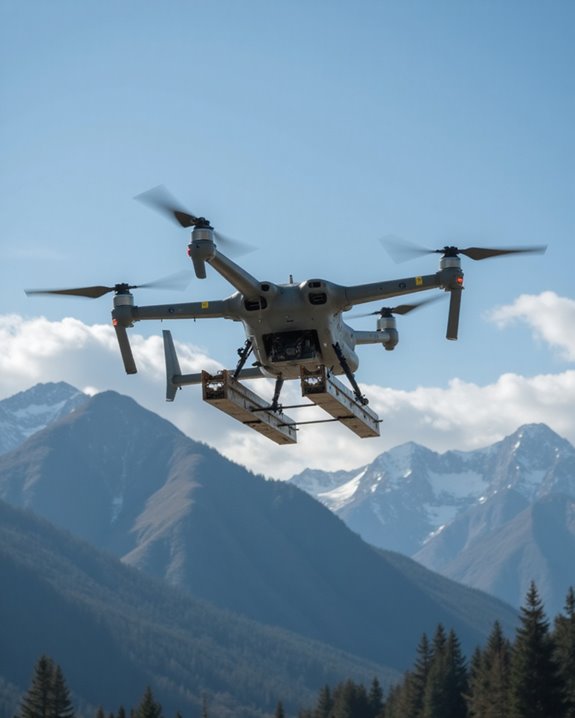
How effectively a heavy lift drone performs depends on several critical design factors that ambitious operators must understand! For professional-grade heavy lifting, brushless motors with superior Motor Efficiency are non-negotiable, as they deliver the substantial thrust required for carrying payloads of 25 kg or more. The thrust-to-weight ratio, ideally 3:1 or 4:1, dramatically impacts both lifting capacity and maneuverability.
Stability Factors play an equally vital role in performance, with robust structural integrity being the backbone of any industrial-grade drone. Just imagine trying to lift 500 pounds with flimsy arms – not happening! Models like the impressive Griff Aviation 300 demonstrate what’s possible, hauling a whopping 227 kg while maintaining 45 minutes of flight time. For operators seeking endurance, the JOUAV CW-80E offers an astonishing 8-hour operational window!
How Payload Affects Flight Time and Range
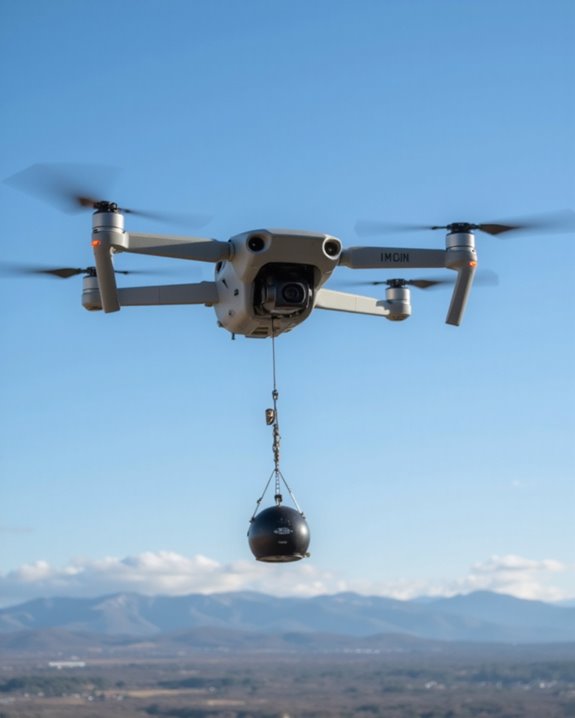
The dramatic relationship between payload weight and flight time creates one of the most significant challenges for drone operators everywhere! When you add weight to your drone, you’re asking its motors to work harder, which drains batteries faster. For example, the Aurelia X8 Standard‘s flight time plummets from 25 to just 12 minutes when carrying an 8 kg payload.
Altitude Effects compound this issue, as thinner air at higher elevations demands even more power. Your drone might perform beautifully at sea level but struggle mightily at 10,000 feet with the same payload! Aerodynamic Drag also plays a key role—larger payloads catch more wind, creating resistance that further reduces flight time. Think of it like swimming with a parachute attached to your back. Finding the perfect balance between payload capacity and range is the golden ticket to drone operation success!
Popular Drone Brands and Their Maximum Loads
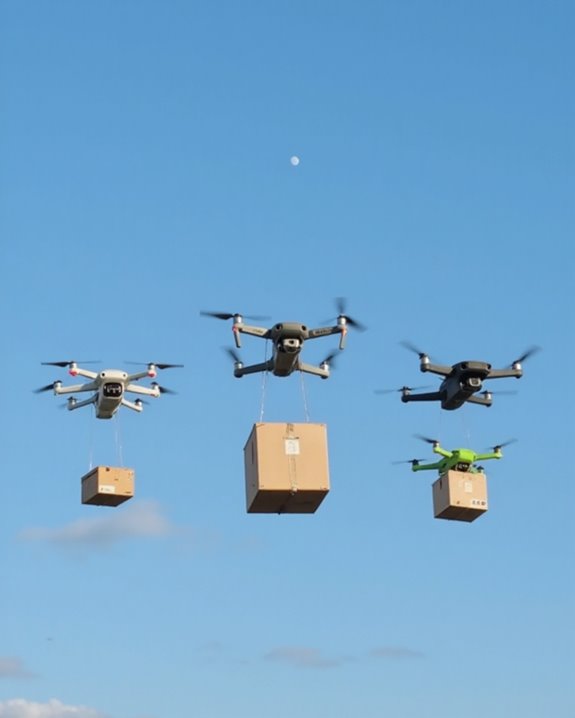
Now that we’ve learned how payload weight affects performance, let’s examine what different drone manufacturers actually offer regarding lifting capacity!
DJI dominates the market with impressive Brand Comparisons across various categories. Their Mavic series handles around 1 kg—perfect for casual photographers looking for that perfect Load Aesthetics in their shots! For professional needs, the Matrice 350 RTK carries up to 960g with specialized gimbal systems, while the agricultural T40 model amazingly increases from 50kg to 90kg takeoff weight with full payload!
Beyond DJI, the drone market offers diverse options: consumer models typically manage up to 5kg, commercial drones handle 3-10kg for real estate and construction work, and specialized delivery drones can transport an impressive 5-50kg of cargo. Talk about heavy lifting!
Military and Industrial Drone Weight Capacities
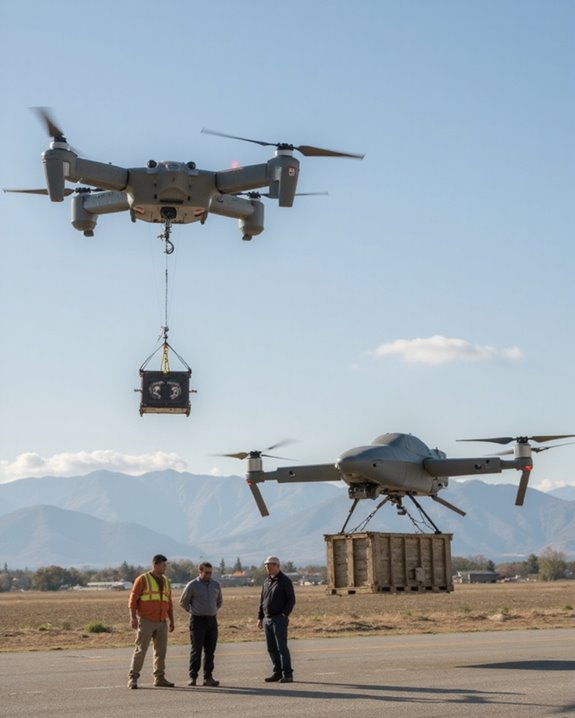
Military and industrial drones represent an entirely different league of aerial power, with carrying capacities that would make consumer models seem like featherweights in comparison! The MQ-9 Reaper can haul an impressive 3,850 pounds of payload, while the newer Predator C Avenger manages a whopping 6,500 pounds total. That’s some serious muscle in the sky!
These hefty lifting capabilities directly impact Armament Limits, allowing military drones to carry everything from sophisticated sensor arrays to precision-guided munitions. Of course, Environmental Effects like high winds and extreme temperatures can reduce these maximum capacities. Industrial drones typically carry between 22-220 pounds, perfect for specialized equipment without requiring the massive infrastructure of their military cousins. Isn’t it amazing how these aerial workhorses keep evolving to carry more while maintaining their operational capabilities?
Regulatory Weight Restrictions for Commercial Operations
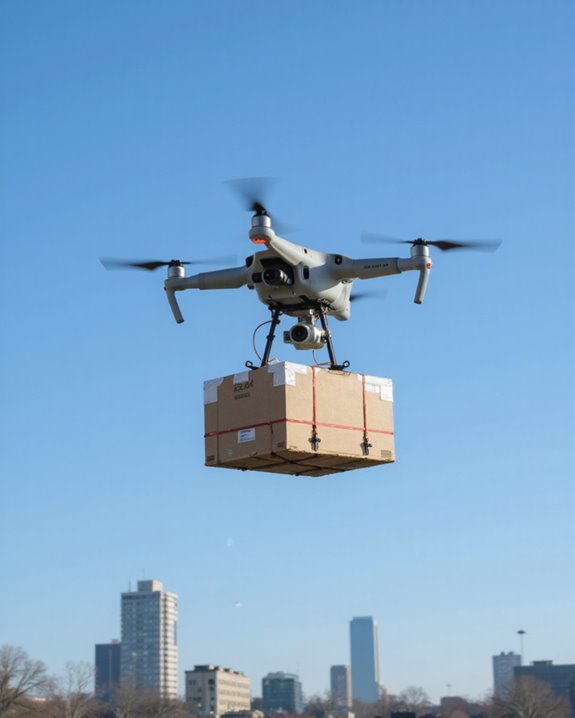
Maneuvering the complex world of regulatory weight restrictions for commercial drone operations can feel like walking through an aerial minefield of rules! The FAA has established clear regulatory thresholds that every commercial operator must follow. Drones weighing between 0.55 and 55 pounds require registration through the FAA DroneZone portal, with compliance fees of $5 per operator lasting three years.
Even tiny drones under 250 grams (0.55 pounds) must be registered when used commercially under Part 107! While these lightweight drones enjoy some advantages, like the ability to fly over people without additional certification, they’re still subject to altitude limits of 400 feet and speed restrictions under 100 mph. Remember, ignoring these regulations can result in hefty fines – so stay compliant, stay legal!
Future Developments in Drone Lifting Technology
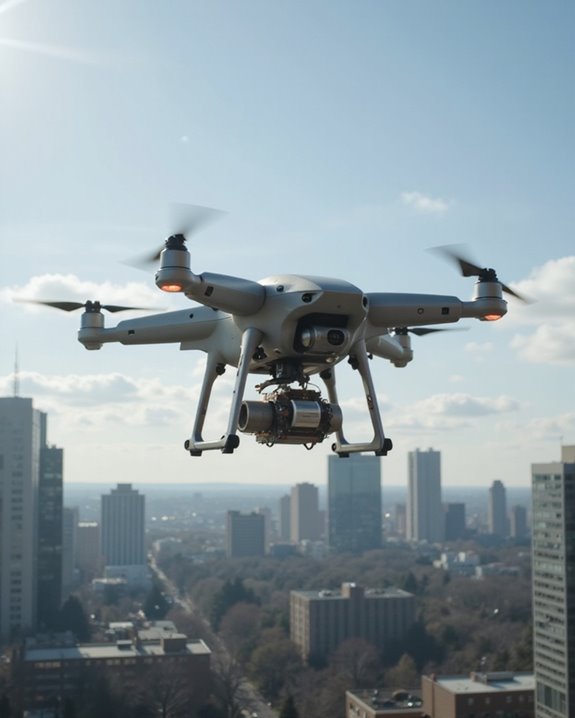
As technological innovations rapidly advance within the drone industry, future developments in drone lifting technology promise to revolutionize what these aerial workhorses can carry! Enhanced propulsion systems and energy storage improvements are leading the charge, with batteries that keep drones aloft longer while supporting heavier payloads. Nanotech innovations are creating lighter yet stronger drone frames that can handle substantially more weight.
Beyond hardware upgrades, AI integration is optimizing cargo distribution and flight paths for maximum efficiency. Quantum propulsion, while still theoretical, could someday enable drones to carry weights that seem impossible today! Autonomous cargo handling systems are eliminating the need for human intervention during loading operations. With BVLOS capabilities expanding and UTM systems becoming more sophisticated, tomorrow’s drones won’t just lift more—they’ll do it smarter, safer, and over much greater distances.
Frequently Asked Questions
Can Drones Carry Humans as Payloads?
Exploring a sea of possibilities, human-carrying drones currently exist as experimental technologies. Heavy lift drones capable of transporting humans have future applications for passenger transport, though ethical implications regarding safety and regulation require careful consideration.
How Does Altitude Affect a Drone’s Maximum Carrying Capacity?
As altitude increases, a drone’s maximum carrying capacity decreases due to reduced air density. This altitude effect diminishes the lift generated by propellers, forcing drones to work harder and limiting their payload capabilities.
Are Waterproof Drones Capable of Carrying Heavier Underwater Payloads?
Waterproof drones typically maintain similar payload capacities underwater as in air. Seawater resistance ratings don’t necessarily enhance weight capacity, while payload buoyancy affects effective weight, potentially allowing slightly heavier underwater loads than aerial ones.
How Do Temperature Extremes Impact Drone Lifting Capabilities?
Temperature troubles tangibly transform drone lifting capabilities. Thermal effects reduce motor efficiency in extreme heat, while cold performance degrades battery capacity. Both conditions diminish air density, requiring more power to maintain lift during flight operations.
Can Drones Be Modified to Exceed Manufacturer Payload Specifications?
Drones can exceed manufacturer payload limits through battery modifications for higher power delivery and propeller swapping to generate additional lift. However, such alterations typically void warranties and may compromise flight stability and safety parameters.




